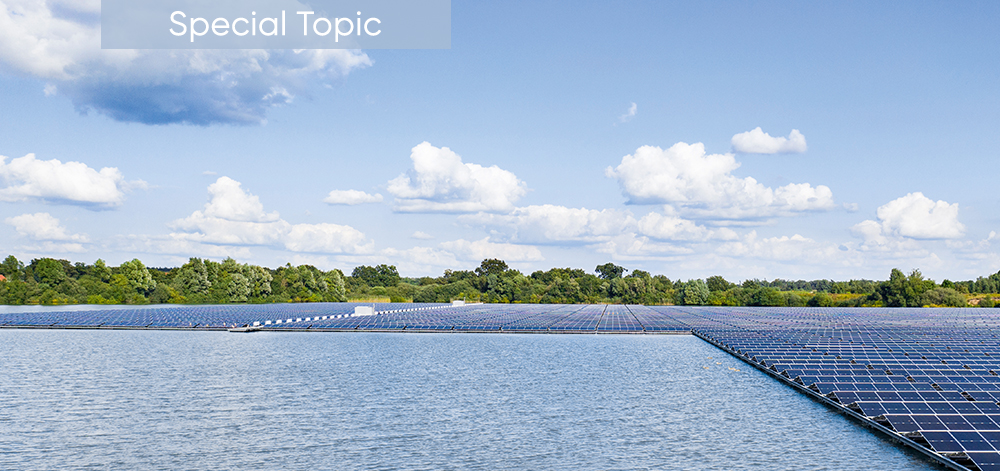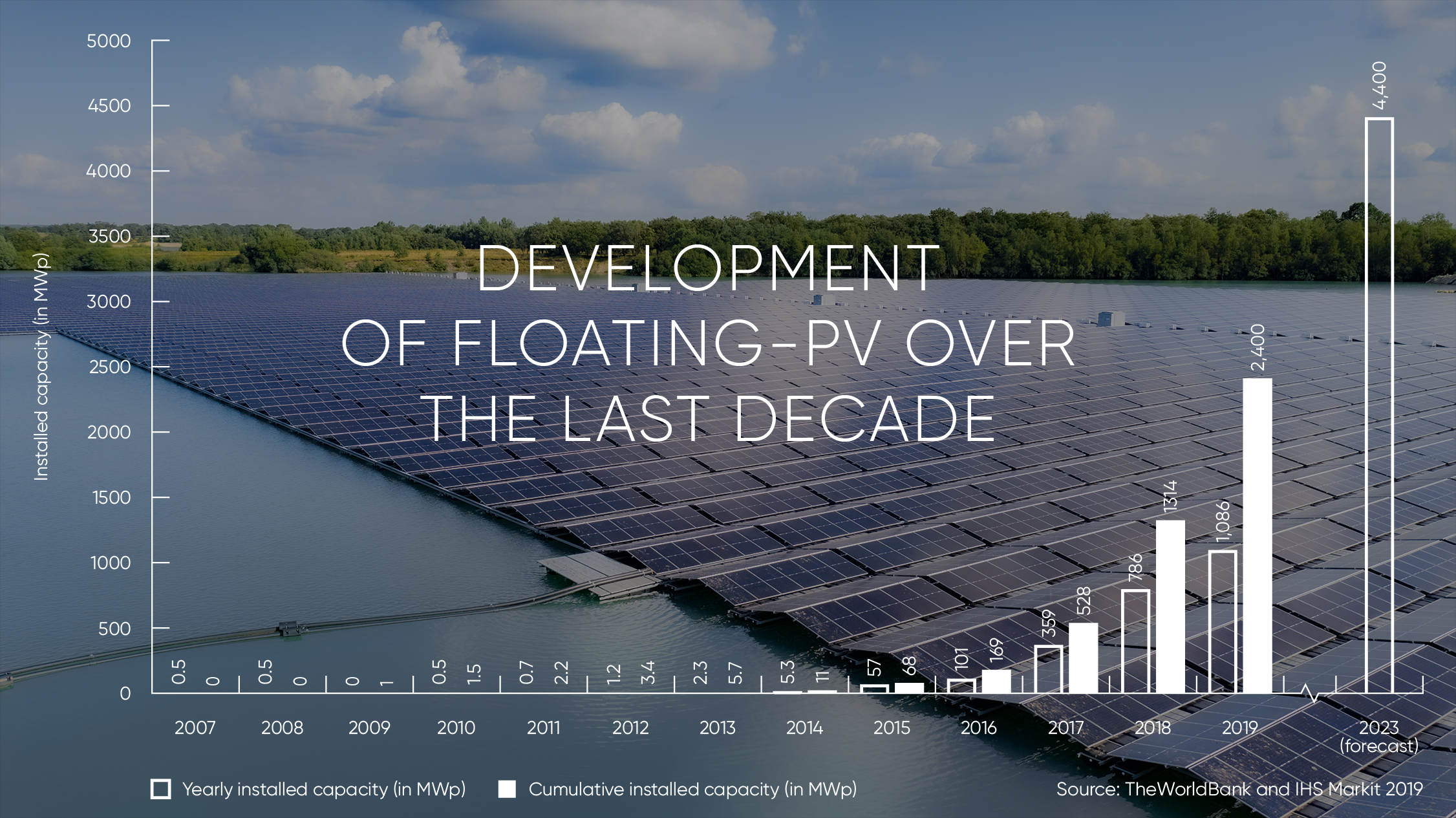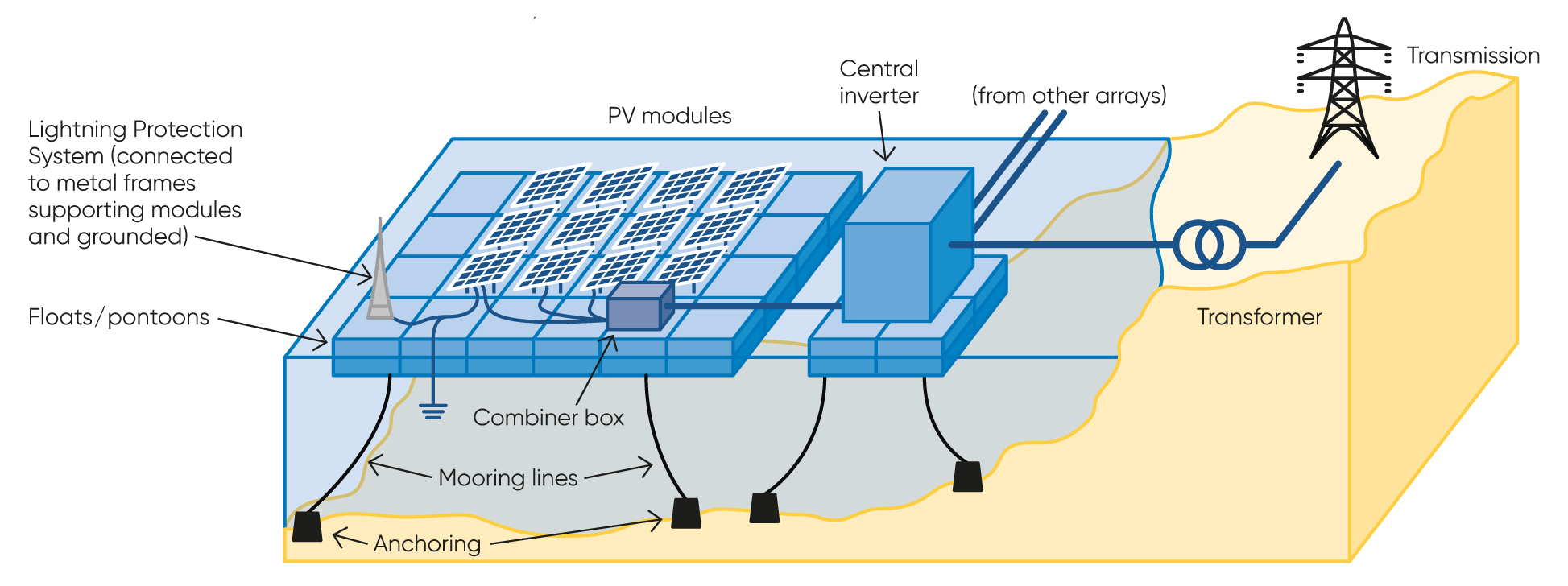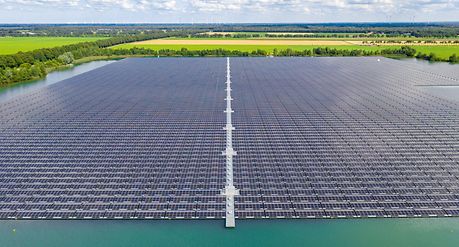XFLEX HYDRO - Roadmap to more flexibility for hydropower plants
Floating PV
A new concept for PV-hydro hybrids
Among non-traditional green energy sources and technologies, Floating Photovoltaics (FPV) is no longer a niche energy solution but is commanding a rapidly developing market position.

Floating PV is increasing renewable energy by using otherwise unused water bodies and already existing infrastructure
Maximizing green power from water with floating solar – Hydrovoltaic energy
As the name suggests, Floating Photovoltaics is a technology which sees the installation of solar panels onto a floating structure, typically plastic or steel pontoons. Aside from the floating element, the PV system is identical to their terrestrial equivalents but offers a number of key advantages. In particular, by using the surface of a water body much of the infrastructure for the plant is located on a space that would otherwise be unused and unproductive.
The relatively recent development of the technology, combined with increased focus on renewable energies, is making FPV extremely attractive to energy investors and this is reflected in recent growth forecasts. According to analysis from the TERI Institute and Acumen Research and Consulting, the global FPV market was worth around € 1 billion in 2019 but will reach some € 21.3 billion by 2027.
Indeed, although Asia is at the forefront of the development, large-scale FPV plants of 100 MW or more are already operating in many countries. Due to shallow water and easy permitting, to date the majority of operating FPV plants are located in disused quarries or other mining or agricultural ponds. This is often combined with local electrical demand from the associated infrastructure. However, although only a small minority of modest pilot projects have been installed on hydropower reservoirs so far, the bulk of these plants are reportedly running well. For example, projects such as Sobradinho in Brazil, Alto Rabagão in Portugal, Sirindhorn in Thailand, and the biggest such example at Longyangxa in China. These hydro-FPV hybrid projects are expected to be expanded where possible.

Source graph: The WorldBank and IHS Markit 2019
ANDRITZ and FPV
ANDRITZ is already looking into this innovative energy solution as an opportunity to maximize hydro asset performance for our clients. We are keen to provide FPV solutions to our hydro business customers as part of an overall optimization approach including as part of Asset Management ISO 55000 Certification.
Hybridization benefits
Of course, like every energy source there are some potential downsides. For example, FPV typically has higher maintenance costs when compared with traditional ground-based PV. It is also possible to see reduced oxygenation in the areas of the reservoir beneath the FPV structure. Nonetheless, FPV does demonstrate an interesting Levelized Cost of Energy (LCOE) when compared with other emerging energy technologies and very reasonable return on investment (ROI).
ANDRITZ is a turnkey “from water-to-wire” player for FPV when combined with hydro power plants or pumped storage plants. ANDRITZ’s huge market presence and access to hydro reservoirs, as well as excellent technical and commercial relationships with clients all over the world, are key advantages. Beyond this, very specific hydro plant operations knowledge and awareness gives ANDRTIZ key insights into FPV installation on a hydro reservoir.
Today, ANDRITZ offers an in-house “hybridized” solution with a smart governor, which optimizes both FPV and hydropower plant operations. This solution acquires and elaborates on input data like forecast for solar irradiation and water availability, the price of energy, limiting operations of the turbines and other parameters in order to optimize the whole plant. The full range of in-house electrical and automation systems enables a complete, ‘full-wrap’ solution, limiting the interfaces that need to be managed by the client.
"ANDRITZ is applying its expertise to innovative energy solutions that can maximize hydropower asset performance for our clients. Providing FPV solutions to our hydro business customers forms a key part of this philosophy."
Hybridization concept
Several large existing utilities company clients are already looking into this innovative energy source to enhance the performance of their hydro assets. Some countries and governments are also preparing specific rules and tenders for FPV, such as Portugal.
A large energy player in Spain is also operatively acting for the construction of an FPV-hydropower hybrid. In early 2021, ANDRITZ signed a Non-Disclosure Agreement as part of an in-depth assessment and the preliminary development of a pipeline of FPV plants combined with existing hydropower reservoirs.
Once again, ANDRITZ is utilizing its multi-disciplinary competences, knowledge and professionalism to help and support our clients to optimize and enhance the performance of their assets. ANDRITZ is ensuring their investments in hybrid hydropower-FPV systems are as profitable as possible.

Floating PV concept
Hybridization benefits at a glimpse
Better energy density | Compared with a ground-bat, water provides natural cooling, increasing efficiency and thus generation. Furthermore, the reservoir surface is generally not utilized for any other purpose, reducing or eliminating the cost of productive use of land. |
Reduced evaporation | Saving water for drinking or additional generation. |
Reduced algae growth | Reduced light penetration thought the water column results in lower algal growth and less maintenance on the water intake. |
Decarbonization | Additional low-carbon energy helps reach company/country targets for CO2 equivalent emissions reduction. |
Longer lifetime of HPP | When combined with FPV, operational optimization can help to reduce start/stop cycles and part-load running. |
Increased plant capacity factor | Overall annual energy production is increased, directly increasing plant revenues. |
Compensating for lack of hydro generation | FPV can mitigate the risk of reduced revenues due to lack of water availability. |
Smarter energy management | Can potentially be used in combination with battery energy storage systems such as HyBaTec for increased flexibility. |
Asset optimization | Overall asset optimization, indirectly increasing revenues and achieving Asset Management ISO 55000 status. |
Reduced capital investment | When combining FPV with HPP / PSP sharing of infrastructure such as electrical power, control and transmission systems reduces the investment required. |
Sediment management | FPV can be used as a base/structure for sediment pumping systems and smart sediment management such as Metris DiOMera. |
Lean authorization process | In many cases the regulations governing water usage are already defined for the hydro generation element. Therefore, additional regulatory approvals are not always needed to add FPV. |
Low investment cost | Limited or no additional land acquisition or civil structures are required. |

Author: Diego Saccon




